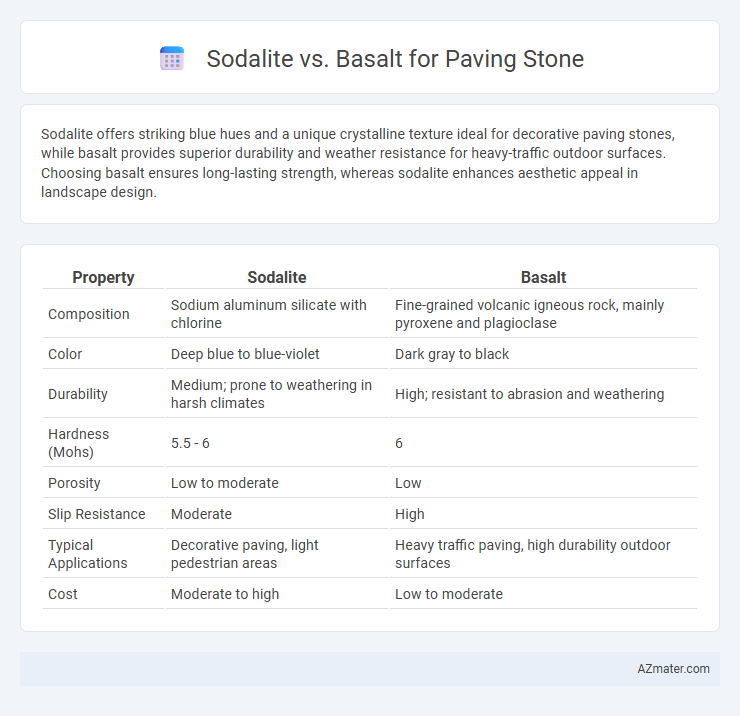Sodalite offers striking blue hues and a unique crystalline texture ideal for decorative paving stones, while basalt provides superior durability and weather resistance for heavy-traffic outdoor surfaces. Choosing basalt ensures long-lasting strength, whereas sodalite enhances aesthetic appeal in landscape design.
Table of Comparison
| Property | Sodalite | Basalt |
|---|---|---|
| Composition | Sodium aluminum silicate with chlorine | Fine-grained volcanic igneous rock, mainly pyroxene and plagioclase |
| Color | Deep blue to blue-violet | Dark gray to black |
| Durability | Medium; prone to weathering in harsh climates | High; resistant to abrasion and weathering |
| Hardness (Mohs) | 5.5 - 6 | 6 |
| Porosity | Low to moderate | Low |
| Slip Resistance | Moderate | High |
| Typical Applications | Decorative paving, light pedestrian areas | Heavy traffic paving, high durability outdoor surfaces |
| Cost | Moderate to high | Low to moderate |
Introduction to Sodalite and Basalt
Sodalite is a rich royal blue tectosilicate mineral commonly used in decorative stone applications due to its vibrant color and unique veining, making it ideal for distinctive paving projects. Basalt, a dense and durable volcanic igneous rock, is renowned for its high compressive strength and resistance to weathering, which positions it as a practical choice for heavy-traffic paving stones. Both materials offer aesthetic and structural benefits, with sodalite emphasizing color and visual appeal, while basalt delivers superior longevity and toughness for outdoor paving installations.
Geological Origins and Composition
Sodalite, a rare blue tectosilicate mineral, forms primarily in silica-poor igneous rocks like nepheline syenites, characterized by its sodium and aluminum-rich composition. Basalt, an abundant extrusive igneous rock, originates from rapid cooling of magnesium and iron-rich lava, resulting in a fine-grained texture dominated by plagioclase and pyroxene minerals. The distinct geological origins influence their durability and aesthetic qualities, as sodalite's mineralogy offers vibrant coloration, while basalt's mafic composition enhances strength and weather resistance for paving stones.
Visual Appeal and Color Variations
Sodalite offers a striking visual appeal with its deep blue hues interspersed with white veins, creating a unique and vibrant aesthetic ideal for decorative paving stones. Basalt, known for its uniform dark gray to black tones, provides a sleek and modern appearance, delivering a more subdued and consistent look. The color variations in sodalite make it a standout choice for projects requiring boldness, while basalt's monochromatic palette ensures timeless elegance and versatility in outdoor spaces.
Durability and Strength Comparison
Sodalite exhibits moderate durability with a Mohs hardness of around 5.5 to 6, making it suitable for low-traffic or decorative paving applications but prone to scratching and weathering over time. Basalt, a dense igneous rock with a Mohs hardness of 6 to 7, offers superior strength and resistance to abrasion, freeze-thaw cycles, and heavy foot or vehicular traffic, ensuring long-lasting performance in paving stone applications. The inherent toughness and low porosity of basalt make it a more durable choice compared to sodalite for outdoor paving projects requiring high strength and wear resistance.
Weather and Slip Resistance
Sodalite and basalt both offer excellent durability for paving stones, but basalt generally provides superior weather resistance due to its dense, volcanic origin, making it more resistant to freeze-thaw cycles and surface degradation. Sodalite's natural crystalline structure offers moderate slip resistance but can become slick when wet, whereas basalt's rough texture and higher porosity enhance grip, reducing slip hazards in wet or icy conditions. For outdoor paving applications in regions with variable weather, basalt emerges as the preferred choice for long-lasting performance and safety.
Installation and Maintenance Requirements
Sodalite paving stones offer ease of installation due to their uniform texture and consistent thickness, reducing leveling challenges compared to basalt. Basalt, with its dense composition, requires specialized cutting tools and careful handling to prevent chipping, increasing installation complexity and time. Maintenance for sodalite involves regular cleaning to preserve its vibrant blue hues, while basalt demands minimal upkeep but may require occasional sealing to prevent surface oxidation and staining.
Cost Analysis: Sodalite vs Basalt
Sodalite paving stones typically cost more than basalt due to their rarity and vibrant blue hues, which increase material and processing expenses. Basalt, being more abundant and easier to quarry, offers a more budget-friendly option for large-scale paving projects while still providing durability and aesthetic appeal. When considering cost analysis, basalt's lower price per square foot makes it preferable for extensive outdoor surfaces, whereas sodalite suits high-end installations where unique coloration justifies the premium.
Environmental Impact and Sustainability
Sodalite, known for its rich blue hues, is less commonly quarried and often sourced from limited deposits, resulting in a lower environmental footprint due to reduced mining activity compared to basalt. Basalt, an abundant volcanic rock, offers high durability and energy-efficient thermal properties, making it a sustainable option for paving that reduces heat island effects in urban areas. Both materials are natural stones with long lifespans, but basalt's widespread availability and recyclability give it an edge in terms of sustainability and environmental impact.
Best Applications for Each Stone
Sodalite is ideal for decorative paving in low-traffic areas, offering vibrant blue hues and aesthetic appeal suitable for patios, garden pathways, and accent borders. Basalt provides exceptional durability and slip resistance, making it the preferred choice for high-traffic surfaces like driveways, commercial walkways, and outdoor stairs. Each stone's mineral composition influences its weather resistance, with basalt excelling in harsh conditions while sodalite is best preserved indoors or in protected outdoor spaces.
Final Recommendations for Paving Stone Choices
Sodalite offers a unique, vibrant blue color ideal for decorative paving, but its relative softness compared to basalt may result in faster wear under heavy traffic. Basalt stands out for its exceptional durability, resistance to weathering, and slip-resistant properties, making it a superior choice for high-traffic and commercial paving applications. For long-lasting, low-maintenance paving stones, basalt is recommended, while sodalite suits aesthetic uses with moderate foot traffic.

Infographic: Sodalite vs Basalt for Paving Stone
 azmater.com
azmater.com